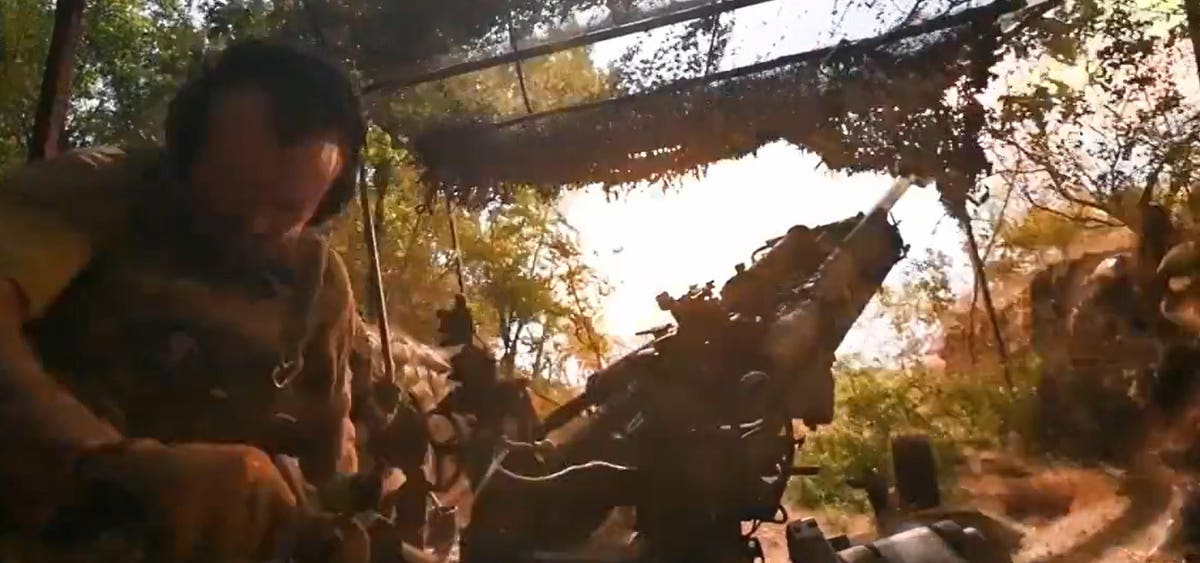In military parlance, “counterbattery” is when artillery fights other artillery. Traditionally, it’s a duel. Two opposing batteries spot each—and fire away until one destroys or scatters the other.
But that’s not how the big guns are fighting in Ukraine, a top Ukrainian artillery officer with the callsign “Arty Green” said this month. Where howitzer-on-howitzer duels were common in Ukraine as recently as 2015, today they “more are a thing of the past,” Arty Green said.
And it’s clear why, explained the aging gunner, who has been fighting the Russian invaders for nine years now.
Drones and precision rounds. Both the Ukrainian and Russian militaries have much wider, around-the-clock aerial surveillance systems than they did in 2014 and 2015. They also have precision-guided shells and rockets.
So when one artillery brigade has an opportunity to strike another artillery brigade, it’s usually because the former’s batteries have spotted the latter’s batteries at distance—20 miles or more—and the target has no idea it’s in the crosshairs until the first laser- or GPS-guided round explodes.
“Now it’s mostly work at longer ranges with precision weapons,” Arty Green said. “If we detect enemy artillery, we select the most appropriate fire system and strike it.”
Ukrainian artillery brigades have an advantage in this new kind of counterbattery fight, Arty Green said, because they get better intelligence—and because they have a deeper arsenal of precision-guided rounds, including Excalibur 155-millimeter shells and M30/31 227-millimeter rockets, both GPS-guided and American-made.
Yes, Russian artillery has its own guided shells—the satellite-guided, 152-millimeter Krasnopols—but these are fewer in number and less accurate than the Excaliburs are. Arty Green altogether dismissed them, perhaps unfairly. “Precision shells—it’s something the Russian army has no answer against,” he said.
It helps that Ukrainian gunners enjoy reliable supply lines and steady supplies of shells and thus usually can fire as soon as a target appears. Russian gunners by contrast have to hope they get lucky.
While Russia’s munitions industry in theory has greater capacity than the combined industries of Ukraine and Ukraine’s Western allies have, the Russians struggle to ship shells from the factories to the front line—because Ukrainian artillery targets the convoys and depots. “The enemy firing less is the result of our strikes on the enemy logistics nodes,” Arty Green said.
The Ukrainian air force—specifically, the air force’s 7th Tactical Aviation Brigade with its Storm Shadow-armed Sukhoi Su-24M bombers—is helping with this counterlogistics effort, Arty Green noted. “Dumps are being taken out.”
Arty Green is a Ukrainian patriot fighting with admittedly strong feelings about the war and his own army’s conduct. But that doesn’t mean he’s wrong, or even exaggerating, about the lopsided counterbattery campaign.
Indeed, third-party tallies of Ukrainian and Russian losses, since Ukraine launched its long-anticipated southern counteroffensive back in June, point to a serious disparity.
One close observer has counted around 70 Russian artillery losses just along the southern front, and just in the last three months. The same observer counted around 20 Ukrainian artillery losses.
The Ukrainians are knocking out more than three Russian howitzers and rocket-launchers for every one Ukrainian howitzer or rocket-launcher the Russians knock out. It’s not a traditional counterbattery fight, but it still is a counterbattery fight—and Ukraine is winning it.
Read the full article here





